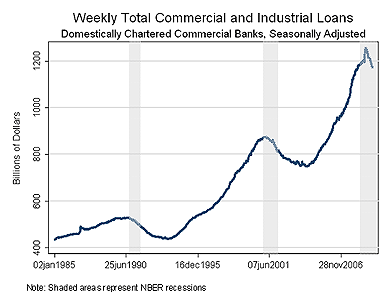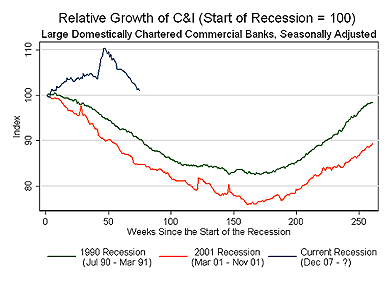Members of the Panel, thank you for giving me the opportunity to discuss with you some of the recent trends in commercial lending, and especially the role banks have played and are playing in the provision of credit to this important sector. My name is Til Schuermann, and I am a vice president of the Federal Reserve Bank of New York. I wish to preface my remarks by noting that they do not reflect the official views of the Federal Reserve Bank of New York or any other component of the Federal Reserve System.
In early 2007, just before the crisis hit, U.S. commercial banks had $10 trillion of assets on their balance sheets. About 60% was composed of what we may think of as traditional banking assets in the form of loans and leases, and of that about $1.2 trillion or 20% was in the form of commercial & industrial (C&I) lending, and about $1.4 trillion or 24% in commercial real estate (CRE) lending, the topics of today’s hearing.1 Meanwhile, the sum total of assets at other important non-bank intermediaries such as finance companies, the government sponsored enterprises (GSEs), investment banks, and—importantly—issuers of securitized non-mortgage assets (such as auto loans, credit card receivables, student and small business loans) was over $16 trillion.
When one adds credit provision though corporate bonds and commercial paper, one realizes that commercial banks have provided only about 20% of total U.S. lending, since the early 90s. The four decades prior had banks’ share closer to 40%. The rise of market-based instead of bank-based credit provision in the last twenty years has been substantial and important.
But banks play a critical role as shock absorbers to the financial system. When times are good, borrowers and investors—i.e., those that need and those that supply funds—seem content to move outside the safety net of the regulated banking system. When a shock hits, however, those investors return to the safety of banks, and firms in turn draw down the loan commitments they have in place for a rainy day. Credit assets such as auto loans, small business loans, credit card receivables and some commercial real estate—once easily securitized and moved off of bank balance sheets into the capital markets—now remain on bank balance sheets and therefore use up scarce lending capacity. In short, banks intermediate when markets don’t or can’t, and what we see is a flight to banks.
At the same time, there is a limit to how much banks can re-intermediate in place of markets, and that limit is typically dictated by capital. Capital is a constraint on banks’ balance sheets, meaning their lending capacity, even in good times. We impose minimum capital standards on banks as a buffer against unexpected losses. Where banks extend credit, regulators and market participants expect that they will have ample capital standing behind those commitments. But during the crisis banks have been confronted with a perfect storm as those very same assets moving onto bank balance sheets, as well as loans and securities already in the banks’ portfolios, face increased risk of credit deterioration and losses, especially if we experience a prolonged and deep recession.
Banks have been playing this role of shock absorber in times of capital market disruption for decades. In this way they helped the markets weather the storm in the fall of 1998 following Russia’s sovereign bond default and the demise of the hedge fund LTCM. And during the dark days of September and October 2008—ten years later—banks faced an unprecedented demand on their balance sheet capacity. By the end of 2008, bank balance sheets had swelled to over $12 trillion (from $10 trillion at the dawn of the crisis).
There are, however, some important differences from 1998, and especially so for C&I and CRE lending. Aside from the obvious and immediate—this financial crisis is far more severe than the turmoil experienced for a few months in the early fall of 1998—we are now in the midst of what many consider to be the worst recession since World War II. We want banks to expand credit, but not at the expense of credit quality. Indeed, lending patterns follow the trends of the overall economy, so that during recessionary times, when demand for credit naturally declines, so does bank lending. It may take some time for bank lending to rebound to pre-recession levels. In the last two recessions, both of which were milder and shorter than the current one, it took at least five years to restore C&I lending to pre-recession levels. The charts that accompany my statement demonstrate this pattern vividly. The first chart shows weekly C&I lending since 1985, with the recession periods shaded in. Lending peaks as one enters the recession and then declines, continuing even after macroeconomic growth resumes. The second chart indexes the same data to 100 at the beginning of the respective recessions and follows lending for five years (or about 250 weeks). In contrast to the previous two recessions, the current recession saw an increase in banks’ C&I balances during the fall of 2008. This reflected onboarding of off-balance sheet assets by banks as well as the drawing down of loan commitments by firms, with the latter effect being especially strong from mid-September to late October of 2008. This ballooning of bank balance sheets exactly reflects the re-intermediation we expect during a time of financial turmoil. It was not until early 2009, one year into the current recession, that we started to see the more typical recessionary pattern of balance sheet decline. But if the previous two recessions are any guide, and to be sure they were milder and shorter than the current one, we may well experience a period of more modest lending at banks before credit demand picks up. This decline will likely be due to a combination of bank capital constraints and reduced market demand for bank loans.
Capital injections, from both private investors and the government, very likely helped significantly in enabling banks to play this important shock absorber role during the current crisis. Not only were banks faced with a sudden and unprecedented demand for balance sheet room, but they were beginning to experience heavy write-downs on loans already made with the prospect of still further write-downs to come. The additional capital raised by the banking system in the course of 2008, and more recently in 2009, has given banks a buffer against future losses, as well as lending headroom that is badly needed in light of the draw-down of commitments that banks have experienced. The result of the recently completed bank stress test has greatly reduced the uncertainty about just how much capital is needed for the largest banks to weather this storm, and to continue to play their credit (re-)intermediation role while capital markets slowly open up again.
The disruption of non-bank lending and investment within the last 18 months has also hit commercial real estate lending hard. Commercial banks have typically provided less than half of the credit consumed by this market. Commercial mortgage backed securities (CMBS) make up about one-quarter of CRE lending, with the rest coming from life insurers, thrifts, GSEs and other financial institutions.2 CMBS issuance has plummeted from over $300 billion in 2007 to under $50 billion in 2008. Banks have picked up some of the slack. So here too, just like in C&I lending, banks are re-intermediating credit where the capital markets have shut.
CRE loans typically have longer maturities, at durations of five or more years, than C&I loans at durations of one to two years. As a result, the pick-up in CRE lending typically lags that of C&I lending as problems surface later and are therefore dealt with more gradually than in faster maturing C&I lending.
Banks cannot pick up all of the slack. Re-invigorating the capital markets to intermediate between the supply and demand for credit is clearly very important. The Federal Reserve’s Term Asset-Backed Securities Loan Facility (TALF) is designed to help with this process by providing financing for the securitization of consumer assets (for example, auto loans, credit cards, student loans and Small Business Administration loans) as well as some CMBS. As a result, spreads in consumer asset securitizations have started to narrow. To be sure, this, like other government programs, is not meant to replace the private markets. Rather, TALF and similar programs are designed to help restart markets by providing some price transparency.
And bankers are starting to see some “green shoots.” The Federal Reserve’s Senior Loan Officer Opinion Survey (SLOOS) suggests that, while the supply of bank credit remains tight, the extent of tightening has abated in recent quarters. One closely watched indicator of banks’ appetite for extending credit is the net percent of loan officers reporting tightening standards for approving new loans. After more than one and a half years of steady tightening, the net percent of loan officers reporting tightening standards for loans to large- and medium-sized firms reached an unprecedented peak of 84% in the fourth quarter of 2008. Since then, however, the net percent tightening has fallen for two consecutive quarters, to 40% in April.3 The tightening in standards for approving CRE loans has also abated, though not so dramatically: the net fraction of lenders reporting tightening standards for CRE dropped from its peak of 87% in the fourth quarter of 2008 to 66% in April 2009. Clearly, the supply of commercial credit remains tight, but just as clearly, the extent of tightening is abating.
The same cannot be said for loan demand. The SLOOS reports that the net fraction of loan officers reporting weaker demand in April 2009 was 60% for C&I and 66% for CRE loans, a historical low for CRE demand. Weak demand bears emphasis, as it indicates that the observed slowdown in overall credit is partly due to firms’ reluctance to borrow, and not entirely to banks reluctance to lend.
In sum, while green shoots may be sprouting in bank lending for commercial purposes—real estate or otherwise—it’s premature to start planning for a harvest. The combination of acute stresses in the financial markets, together with stresses on bank balance sheets, in the middle of the worst recession in a generation, should caution us from believing that recovery is just around the corner.
Thank you for the invitation to appear before you today. I look forward to your questions.
__________________________________
1 Source: FDIC Statistics on Banking
2 Source: Commercial Mortgage Securities Association Compendium of Statistics, May 15, 2009.
3 Source: Senior Loan Officer Opinion Survey on Bank Lending Practices Chart Data
Appendix


Source: Federal Reserve H.8 data: Assets and Liabilities of Commercial Banks in the United States










